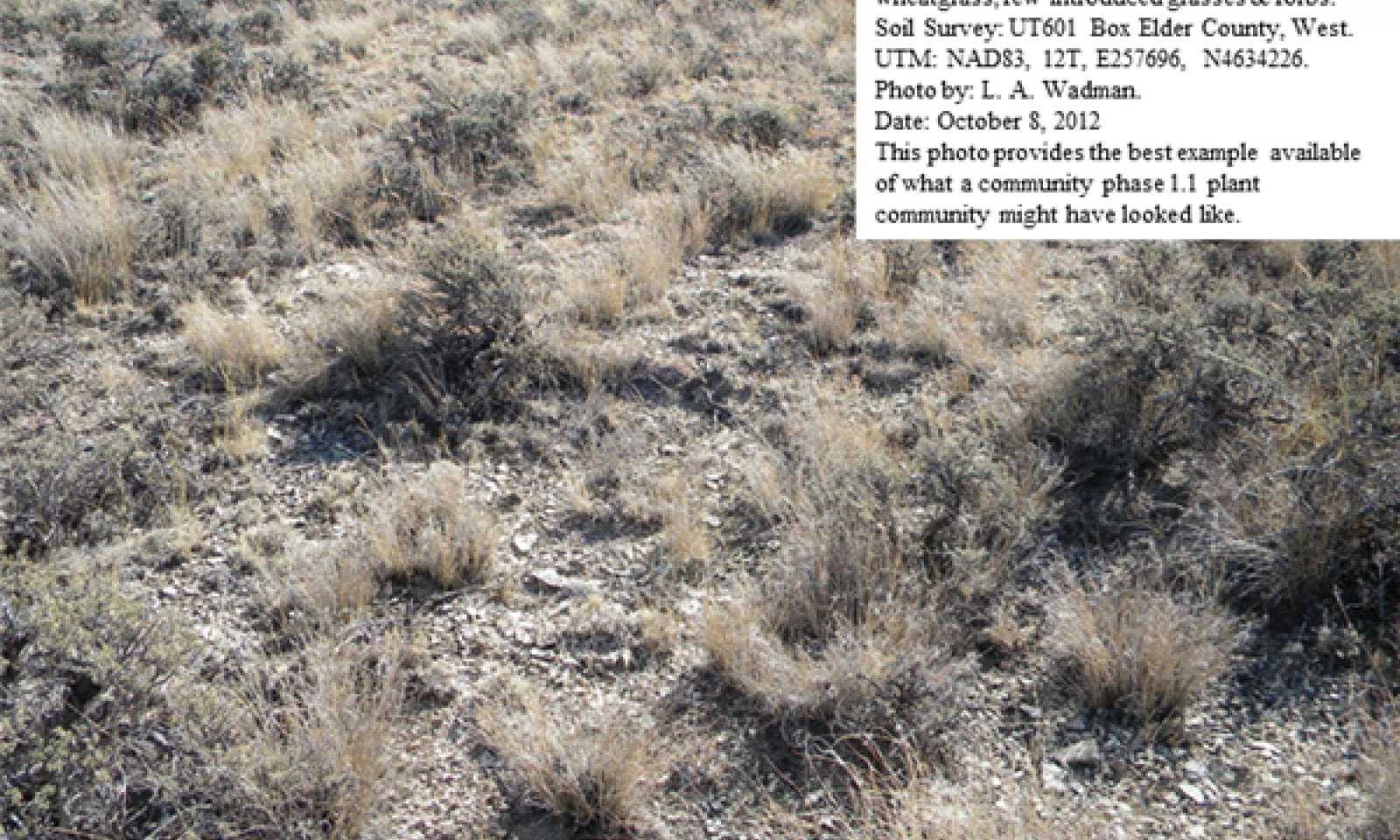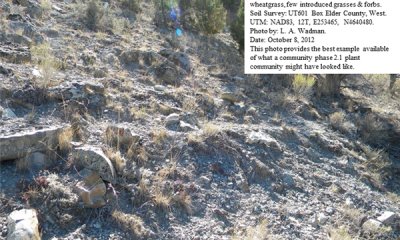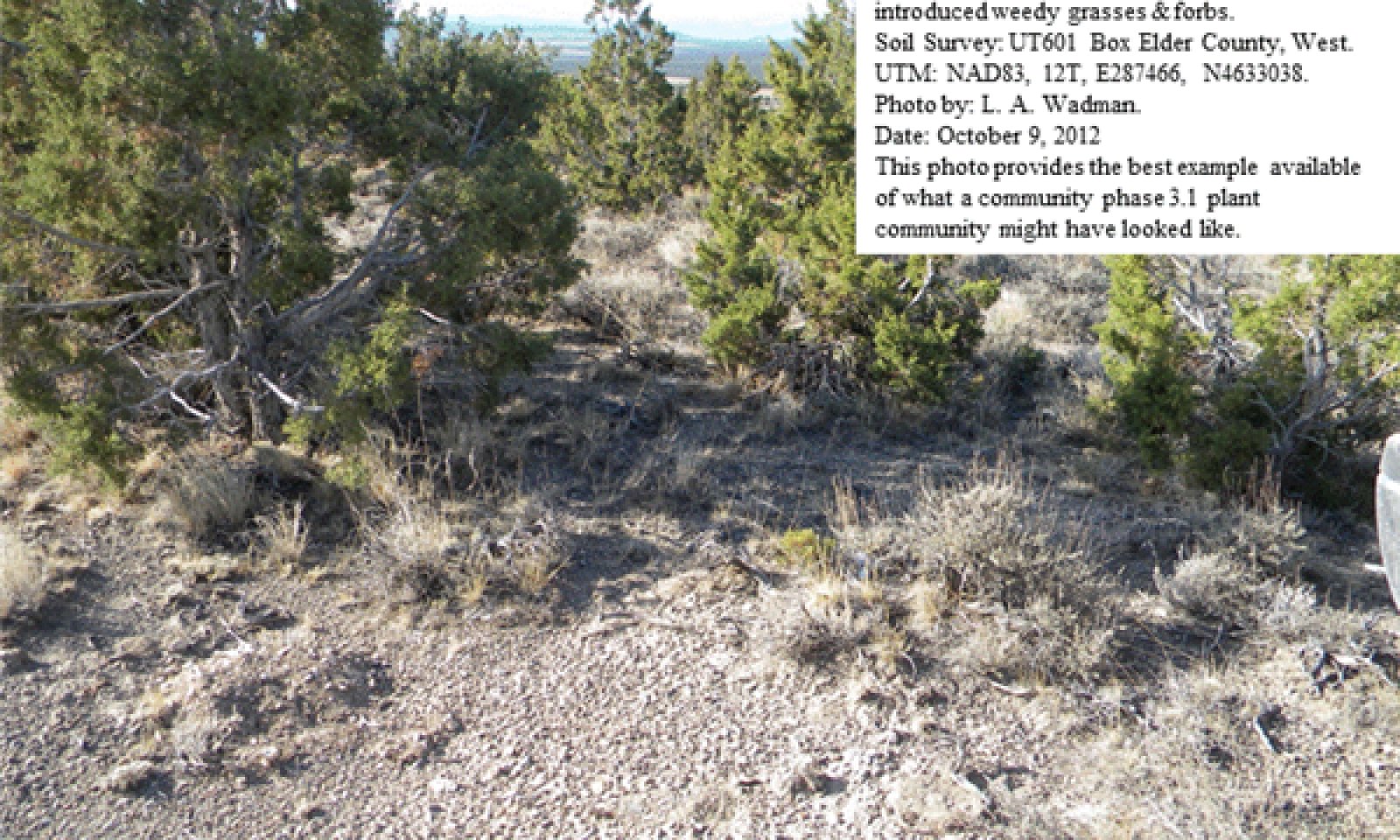
Upland Stony Loam (Black Sagebrush)
Scenario model
Current ecosystem state
Select a state
Management practices/drivers
Select a transition or restoration pathway
- Transition T1A More details
- Transition T2A More details
-
No transition or restoration pathway between the selected states has been described
Target ecosystem state
Select a state
Description
This state describes the various biotic communities that are expected to be found on this ecological site under natural conditions. This reference state has a well developed shrub layer with black sagebrush dominating. Antelope bitterbrush and slender buckwheat are other common shrub species. Bluebunch wheatgrass is the dominant herbaceous species with Nevada bluegrass and Indian ricegrass commonly occurring. Other native grasses, forbs, and shrubs will often produce a significant portion of vegetative composition in the plant community.
This site occurs on 3 to 25% slopes on all aspects. It is usually found on more gentle fan remnants and hills. Its soils are deep, well drained and gravelly loams in texture.
The reference state is self-sustaining and resistant to change due to a good natural resilience to its natural disturbances. The primary natural disturbance mechanisms are wildlife population densities which can affect the shrub layer composition, weather fluctuations, and fire period.
Definitions:
Reference State: Natural plant communities as influenced by shrub canopy density, long term weather fluctuations, and periodic fire.
Indicators: These communities are dominated by black sagebrush and bluebunch wheatgrass. The density of the shrub canopy determines the amount and composition of the other native species present in the community.
Feedbacks: Natural fluctuations in weather patterns that allow for a self-sustaining shrub and native grass community. Prolonged drought, an increase in fire frequency, or other disturbances may allow for the establishment of invasive species.
At-risk Community Phase: All communities are at risk when native plants are stressed and conditions are created that may allow invasive plants to establish.
Trigger: The establishment of invasive plant species.
Submodel
Description
The Current Potential State is similar to the Reference Sate except that non-native species are now present. This state describes the plant communities that may or have become established on this ecological site under various successional sequences and disturbance conditions. This state typically has a well developed shrub layer with black sagebrush often dominating. Antelope bitterbrush and slender buckwheat are other common shrub species. Bluebunch wheatgrass is the dominant herbaceous species with Nevada bluegrass and other perennial grasses and forbs commonly found in abundance also. These other native grasses, forbs, and shrubs may produce significant composition in the plant community. Cheatgrass, alyssum, various mustard species and other non-native species are present on the site and under certain circumstances, may visually dominate the sites aspect.
The primary disturbance mechanisms are the shrub layer density; the amount of invasive species present; weather fluctuations; and fire. The current potential state is still self-sustaining but may be losing its resistance to change due to the impact of disturbances with less resilience following those disturbances.
Definitions:
Current Potential State: Plant communities influenced by shrub canopy density, long term weather fluctuations, and periodic fire. Invasive species are present in various amounts.
Indicators: A community dominated by black sagebrush and bluebunch wheatgrass. The density of the shrub canopy determines the amount and composition of the other native and introduced grasses and forbs that may be present.
Feedbacks: Natural fluctuations in weather patterns that allow for a self sustaining shrub and native grass community. Prolonged drought, more frequent fires, and/or other disturbances that may allow for the increase of invasive species.
At-risk Community Phase: All communities are at risk when native plants are stressed and nutrients become available for invasive plants to increase.
Trigger: A reduction of perennial grass and forb species combined with an increase of invasive plant species.
Submodel
Description
The Juniper Invasion/Invasive Weed State is similar to the Current Potential State except that Utah juniper along with various non-native species is now present. This state describes the plant communities that may or have become established on this ecological site under various successional sequences and disturbance conditions. This state is dominated by Utah juniper and typically has a well developed shrub layer as well, with black sagebrush often dominating. Antelope bitterbrush and slender buckwheat are much reduced or may not be present. Bluebunch wheatgrass and other native perennial grass species are also reduced or missing from the herbaceous layer. Nevada bluegrass is usually still present and along with invasive weedy species, including cheatgrass, alyssum, various mustard species and other non-native species, may visually dominate the sites herbaceous layer.
The primary disturbance mechanisms include an overstory of Utah juniper; a shrub layer comprised of various amounts of black sagebrush; significant amounts of invasive herbaceous species present; weather fluctuations, and fire patterns. This state is losing its resistance to change due to the impact of these disturbances and has less resilience following those disturbances.
Definitions:
Juniper Invasion State: Plant communities dominated by an overstory of Utah juniper; a shrub canopy typically composed of black sagebrush of various densities; long term weather fluctuations; and periodic fire.
Indicators: The density of the tree and shrub canopies determines the amount and composition of the other native and introduced grasses and forbs that may be present.
Feedbacks: Natural fluctuations in weather patterns that allow Utah juniper to invade and impact the native shrub and grass communities. Prolonged drought, less frequent fire, and/or other disturbances that allow for the increase of all invasive species.
At-risk Community Phase: All communities are at risk when native plants are stressed and nutrients become available for invasive plants to increase.
Trigger: A reduction of perennial grass and forb species combined with an increase of invasive plant species.
Submodel
Mechanism
This transitional pathway occurs when any combination of drought and a lack of fire allow non-native, invasive species to occupy the site. Improper livestock grazing can stress the community by decreasing palatable perennial grasses and forbs, creating areas for these species to become well established. Once non-native species such as cheatgrass, alyssum, Russian thistle, etc. are present, a threshold has been crossed.
Mechanism
This transitional pathway occurs when extended drought and a lack of fire to allow Utah juniper along with non-native, invasive species to fully occupy the site. Improper livestock grazing can add additional stress the community by decreasing palatable perennial grasses and forbs, creating areas for these species to become well established.
Model keys
Briefcase
Add ecological sites and Major Land Resource Areas to your briefcase by clicking on the briefcase (![]() ) icon wherever it occurs. Drag and drop items to reorder. Cookies are used to store briefcase items between browsing sessions. Because of this, the number of items that can be added to your briefcase is limited, and briefcase items added on one device and browser cannot be accessed from another device or browser. Users who do not wish to place cookies on their devices should not use the briefcase tool. Briefcase cookies serve no other purpose than described here and are deleted whenever browsing history is cleared.
) icon wherever it occurs. Drag and drop items to reorder. Cookies are used to store briefcase items between browsing sessions. Because of this, the number of items that can be added to your briefcase is limited, and briefcase items added on one device and browser cannot be accessed from another device or browser. Users who do not wish to place cookies on their devices should not use the briefcase tool. Briefcase cookies serve no other purpose than described here and are deleted whenever browsing history is cleared.
Ecological sites
Major Land Resource Areas
The Ecosystem Dynamics Interpretive Tool is an information system framework developed by the USDA-ARS Jornada Experimental Range, USDA Natural Resources Conservation Service, and New Mexico State University.










